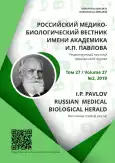Peculiarities of physical development and of level of nutrients in children with autistic spectrum disorders
- Authors: Bavykinа I.A.1
-
Affiliations:
- N.N. Burdenko Voronezh State Medical University
- Issue: Vol 27, No 2 (2019)
- Pages: 181-187
- Section: Original study
- URL: https://journals.rcsi.science/pavlovj/article/view/14537
- DOI: https://doi.org/10.23888/PAVLOVJ2019272181-187
- ID: 14537
Cite item
Abstract
Aim. To study the state of physical development and the level of calcium and iron in children and adolescents with autistic spectrum disorders taking into account the characteristics of eating behavior.
Materials and Methods. 64 children aged 2.5 to 15 years with autistic spectrum disorders were assessed for physical development according to WHO standards, and for iron and total calcium in the blood. Parents of children were surveyed on issues related to the peculiarities of eating behavior in their children.
Results. In 21.9% of children and adolescents with autistic spectrum disorders, alteration of nutritional status was manifested by an increase in the body mass index and in 18.7% – by a decrease in it. 1st-2nd degree obesity was found in 12.5%, 1st degree protein-energy insufficiency in 6.2% of the examined children. Laboratory tests revealed a decreased level of serum iron in 37.3 % of children, and of total calcium in 45.1%. At the same time, in children being kept on gluten-free diet for a long time, iron level increased with age, in contrast to those who did not use diet therapy (p<0.05). The vast majority of children with autistic spectrum disorders exhibited a selective appetite (73.4%) with predomination of easily digestible carbohydrates in their diet.
Conclusion. No significant alterations in the parameters of physical development of children with autistic spectrum disorders were found in comparison with the population. With this, in children with autistic spectrum disorders lower parameters of serum iron and calcium were observed that could be corrected by following a diet.
Full Text
##article.viewOnOriginalSite##About the authors
Irina A. Bavykinа
N.N. Burdenko Voronezh State Medical University
Author for correspondence.
Email: www.i-bavikina@yandex.ru
ORCID iD: 0000-0003-1062-7280
SPIN-code: 5677-2002
ResearcherId: M-3133-2016
MD, PhD, Аssistant of the Department of Hospital and Polyclinic Pediatrics
Russian Federation, VoronezhReferences
- Novikova VP, Volkova IS. Fizicheskoye razvitiye detey pervogo goda zhizni v zavisimosti ot pokazateley massy tela pri rozhdenii. In: Aktual’nyye voprosy pediatrii i perinatologii: sbornik rabot, posvyashchennyy 35-letiyu FGBU «SZFMITS im. V.A. Almazova». Saint-Petersburg; 2015. P. 263-264. (In Russ).
- Tolmachëva AS, Sukhareva EA, Panina OA, et al. Faktory, vliyayushchiye na sostoyaniye zdorov’ya uchashchikhsya obshcheobrazovatel’nykh shkol. In: Gigiyenicheskiye i ekologicheskiye aspekty profilaktiki zabolevayemosti na regional’nom urovne: materialy III Mezhvuzovskoy nauchno-prakticheskoy konfe-rentsii. Voronezh; 2018. Р. 76-9. (In Russ).
- Bavykina IA, Nastausheva TL, Bavykin DV, et al. The nutritional status of children with down syndrome. Nauchno-medicinskij vestnik Central'nogo Chernozem'ya. 2018;(72):98-100. (In Russ).
- Plaksunova EV. Research of physical development and motor abilities of students with autism spectrum disorders. Autism and Developmental Disorders. 2014;12(1;42):26-32. (In Russ).
- Novikova VP, Volkova IS, Vorontsova LV. Vliyaniye nutriyentov na kognitivnyye funktsii. In: Znaniye propedevtiki – osnova klinicheskogo myshleniya pediatra: sbornik trudov, posvyashchennyy 80-letiyu prof. A.Ya. Puchkovoy. Saint-Petersburg; 2015. P. 222-233. (In Russ).
- Zvyagin AA, Bavykina IA. Gluten-free diet effectiveness in treatment of autism spectrum disorders in children. Pediatria. Journal named after G.N. Speransky. 2017;96(6):197-200. (In Russ). doi:10. 24110/0031-403x-2017-96-6-197-200
- Pusponegoro HD, Ismael S, Firmansyah A, et al. Gluten and casein supplementation does not increase symptoms in children with autism spectrum disorder. Acta Paediatrica. 2015;104(11): 500-5. doi: 10.1111/apa.13108
- Ghalichi F, Ghaemmaghami J, Malek A, et al. Effect of gluten free diet on gastrointestinal and behavioral indices for children with autism spectrum disorders: a randomized clinical trial. World Journal of Pediatrics. 2016;12(4):436-42. doi:10.1007/ s12519-016-0040-z
- Klimov LYa, Abramskaya LM, Stoyan MV, et al. Pokazateli obespechennosti vitaminom D detey i podrostkov s tseliakiyey. Voprosy Detskoy Diye-tologii. 2016;14(3):42-3. (In Russ).
- Klimov LYa, Stoyan MV, Kur’yaninova VA, et al. Vzaimosvyaz’ fizicheskogo razvitiya i obespechen-nosti zhelezom detey i podrostkov v aktivnom periode tseliakii. Voprosy Detskoy Diyetologii. 2016; 14(3):43. (In Russ).
- Esaulenko IE, Nastausheva TL, Zhdanovа OA, et al. Characteristics of Voronezh schoolchildren physical development and nutrition behavior. Problems of Nutrition. 2017;86(4):85-92. (In Russ).
- The WHO Child Growth Standards. https://www. who.int/childgrowth/standards/ru/
- Diagnostika, lecheniye i profilaktika diabeticheskikh oslozhneniy u detey i podrostkov endokrinologi-cheskiy nauchnyy tsentr Rossiyskoy akademii meditsinskikh nauk. Moscow; 1997. (In Russ).
- Agandeeva MS, Ivanova I. Prevalence of iron deficiency in children. Health Care of Chuvashia. 2015;(4): 86-93. (In Russ).
- UNICEF, United Nations University, WHO. Iron deficiency anemia: assessment, prevention and control. A guide for programme managers. Geneva: World Health Organization; 2001.
- Postorino V, Sanges V, Giovagnoli G, et al. Clinical differences in children with autism spectrum disorder with and without food selectivity. Appetite. 2015;(92):126-32.
Supplementary files








